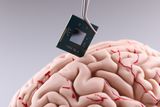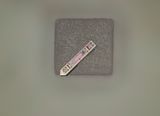Brain Microchip Smaller Than a Grain of Salt Sends Data Using Lasers and Satellite Technology





A realistic and cost-effective path for the United States to advance the exploration and development of the moon, and to keep our nation in the forefront of that enterprise, is to dramatically increase robotic exploration efforts and to focus with urgency on a comprehensive campaign to collect and return geologic samples from a wide range […]
The post Accelerate U.S. lunar exploration with a robotic sample return campaign appeared first on SpaceNews.

In space policy today, Republican views dominate. The party holds majorities in the House and Senate, while the White House is stretching — or breaking — the limits of executive power. Democratic views on space are largely couched in terms of opposition to White House initiatives, such as proposed cuts in NASA’s budget or efforts […]
The post Crafting a Democratic space policy in the Trump era appeared first on SpaceNews.
The LIGO–Virgo–KAGRA collaboration has detected strong evidence for second-generation black holes, which were formed from earlier mergers of smaller black holes. The two gravitational wave signals provide one of the strongest confirmations to date for how Einstein’s general theory of relativity describes rotating black holes. Studying such objects also provides a testbed for probing new physics beyond the Standard Model.
Over the past decade, the global network of interferometers operated by LIGO, Virgo, and KAGRA have detected close to 300 gravitational waves (GWs) – mostly from the mergers of binary black holes.
In October 2024, the network detected a clear signal that pointed back to a merger that occurred 700 million light–years away. The progenitor black holes were 20 and 6 solar masses and the larger object was spinning at 370 Hz, which makes it one of the fastest-spinning black holes ever observed.
Just one month later, the collaboration detected the coalescence of another highly imbalanced binary (17 and 8 solar masses), 2.4 billion light–years away. This signal was even more unusual – showing for the first time that the larger companion was spinning in the opposite direction of the binary orbit.
While conventional wisdom says black holes should not be spinning at such high rates, the observations were not entirely unexpected. “With both events having one black hole, which is both significantly more massive than the other and rapidly spinning, [the observations] provide tantalizing evidence that these black holes were formed from previous black hole mergers,” explains Stephen Fairhurst at Cardiff University, spokesperson of the LIGO Collaboration. If this were the case, the two GW signals – called GW241011 and GW241110 – are first observations of second-generation black holes. This is because when a binary merges, the resulting second-generation object tends to have a large spin.
The GW241011 signal was particularly clear, which allowed the team to make the third-ever observation of higher harmonic modes. These are overtones in the GW signal that become far clearer when the masses of the coalescing bodies are highly imbalanced.
The precision of the GW241011 measurement provides one of the most stringent verifications so far of general relativity. The observations also support Roy Kerr’s prediction that rapid rotation distorts the shape of a black hole.
“We now know that black holes are shaped like Einstein and Kerr predicted, and general relativity can add two more checkmarks in its list of many successes,” says team member Carl-Johan Haster at the University of Nevada, Las Vegas. “This discovery also means that we’re more sensitive than ever to any new physics that might lie beyond Einstein’s theory.”
This new physics could include hypothetical particles called ultralight bosons. These could form in clouds just outside the event horizons of spinning black holes, and would gradually drain a black hole’s rotational energy via a quantum effect called superradiance.
The idea is that the observed second-generation black holes had been spinning for billions of years before their mergers occurred. This means that if ultralight bosons were present, they cannot have removed lots of angular momentum from the black holes. This places the tightest constraint to date on the mass of ultralight bosons.
“Planned upgrades to the LIGO, Virgo, and KAGRA detectors will enable further observations of similar systems,” Fairhurst says. “They will enable us to better understand both the fundamental physics governing these black hole binaries and the astrophysical mechanisms that lead to their formation.”
Haster adds, “Each new detection provides important insights about the universe, reminding us that each observed merger is both an astrophysical discovery but also an invaluable laboratory for probing the fundamental laws of physics”.
The observations are described in The Astrophysical Journal Letters.
The post Rapidly-spinning black holes put new limit on ultralight bosons appeared first on Physics World.

Deloitte’s ‘Silent Shield’ payloads will test cyber defenses in orbit
The post The race to defend satellites from cyberattacks appeared first on SpaceNews.

German satellite manufacturer Reflex Aerospace has raised 50 million euros ($57.4 million) as it rides a growing wave of interest and investment in European space systems.
The post Reflex Aerospace raises 50 million euros appeared first on SpaceNews.

China’s human spaceflight agency has delayed the scheduled return to Earth of a crewed Shenzhou spacecraft due to a suspected space debris impact.
The post China delays Shenzhou-20 crew return after suspected space debris impact appeared first on SpaceNews.
Quantum error correction codes protect quantum information from decoherence and quantum noise, and are therefore crucial to the development of quantum computing and the creation of more reliable and complex quantum algorithms. One example is the five-qubit error correction code, five being the minimum number of qubits required to fix single-qubit errors. These contain five physical qubits (a basic off/on unit of quantum information made using trapped ions, superconducting circuits, or quantum dots) to correct one logical qubit (a collection of physical qubits arranged in such a way as to correct errors). Yet imperfections in the hardware can still lead to quantum errors.
A method of testing quantum error correction codes is self-testing. Self-testing is a powerful tool for verifying quantum properties using only input-output statistics, treating quantum devices as black boxes. It has evolved from bipartite systems consisting of two quantum subsystems, to multipartite entanglement, where entanglement is among three or more subsystems, and now to genuinely entangled subspaces, where every state is fully entangled across all subsystems. Genuinely entangled subspaces offer stronger, guaranteed entanglement than general multipartite states, making them more reliable for quantum computing and error correction.
In this research, self-testing techniques are used to certify genuinely entangled logical subspaces within the five-qubit code on photonic and superconducting platforms. This is achieved by preparing informationally complete logical states that span the entire logical space, meaning the set is rich enough to fully characterize the behaviour of the system. They deliberately introduce basic quantum errors by simulating Pauli errors on the physical qubit, which mimics real-world noise. Finally, they use mathematical tests known as Bell inequalities, adapted to the framework used in quantum error correction, to check whether the system evolves in the initial logical subspaces after the errors are introduced.
Extractability measures tell you how close the tested quantum system is to the ideal target state, with 1 being a perfect match. The certification is supported by extractability measures of at least 0.828 ± 0.006 and 0.621 ± 0.007 for the photonic and superconducting systems, respectively. The photonic platform achieved a high extractability score, meaning the logical subspace was very close to the ideal one. The superconducting platform had a lower score but still showed meaningful entanglement. These scores show that the self-testing method works in practice and confirm strong entanglement in the five-qubit code on both platforms.
This research contributes to the advancement of quantum technologies by providing robust methods for verifying and characterizing complex quantum structures, which is essential for the development of reliable and scalable quantum systems. It also demonstrates that device-independent certification can extend beyond quantum states and measurements to more general quantum structures.
Certification of genuinely entangled subspaces of the five qubit code via robust self-testing
Yu Guo et al 2025 Rep. Prog. Phys. 88 050501
Quantum error correction for beginners by Simon J Devitt, William J Munro and Kae Nemoto (2013)
The post Making quantum computers more reliable appeared first on Physics World.
For almost a century, physicists have tried to understand why and how materials become magnetic. From refrigerator magnets to magnetic memories, the microscopic origins of magnetism remain a surprisingly subtle puzzle — especially in materials where electrons behave both like individual particles and like a collective sea.
In most transition-metal compounds, magnetism comes from the dance between localized and mobile electrons. Some electrons stay near their home atoms and form tiny magnetic moments (spins), while others roam freely through the crystal. The interaction between these two types of electrons produces “double-exchange” ferromagnetism — the mechanism that gives rise to the rich magnetic behaviour of materials such as manganites, famous for their colossal magnetoresistance (a dramatic change in electrical resistance under a magnetic field). Traditionally, scientists modelled this behaviour by treating the localized spins as classical arrows — big and well-defined, like compass needles. This approximation works well enough for explaining basic ferromagnetism, but experiments over the last few decades have revealed strange features that defy the classical picture. In particular, neutron scattering studies of manganites showed that the collective spin excitations, called magnons, do not behave as expected. Their energy spectrum “softens” (the waves slow down) and their sharp signals blur into fuzzy continua — a sign that the magnons are losing their coherence. Until now, these effects were usually blamed on vibrations of the atomic lattice (phonons) or on complex interactions between charge, spin, and orbital motion.

A new theoretical study challenges that assumption. By going fully quantum mechanical — treating every localized spin not as a classical arrow but as a true quantum object that can fluctuate, entangle, and superpose — the researchers have reproduced these puzzling experimental observations without invoking phonons at all. Using two powerful model systems (a quantum version of the Kondo lattice and a two-orbital Hubbard model), the team simulated how electrons and spins interact when no semiclassical approximations are allowed. The results reveal a subtle quantum landscape. Instead of a single type of electron excitation, the system hosts two. One behaves like a spinless fermion — a charge carrier stripped of its magnetic identity. The other forms a broad, “incoherent” band of excitations arising from local quantum triplets. These incoherent states sit close to the Fermi level and act as a noisy background — a Stoner-like continuum — that the magnons can scatter off. The result: magnons lose their coherence and energy in just the way experiments observe.
Perhaps most surprisingly, this mechanism doesn’t rely on the crystal lattice at all. It’s an intrinsic consequence of the quantum nature of the spins themselves. Larger localized spins, such as those in classical manganites, tend to suppress the effect — explaining why decoherence is weaker in some materials than others. Consequently, the implications reach beyond manganites. Similar quantum interplay may occur in iron-based superconductors, ruthenates, and heavy-fermion systems where magnetism and superconductivity coexist. Even in materials without permanent local moments, strong electronic correlations can generate the same kind of quantum magnetism.
In short, this work uncovers a purely electronic route to complex magnetic dynamics — showing that the quantum personality of the electron alone can mimic effects once thought to require lattice distortions. By uniting electronic structure and spin excitations under a single, fully quantum description, it moves us one step closer to understanding how magnetism truly works in the most intricate materials.
Magnon damping and mode softening in quantum double-exchange ferromagnets
A Moreo et al 2025 Rep. Prog. Phys. 88 068001
Nanoscale electrodynamics of strongly correlated quantum materials by Mengkun Liu, Aaron J Sternbach and D N Basov (2017)
The post Quantum ferromagnets without the usual tricks: a new look at magnetic excitations appeared first on Physics World.


The White House said Nov. 4 it is renominating Jared Isaacman to be NASA administrator, the latest twist in an unprecedented saga over the agency’s leadership.
The post White House renominates Isaacman to be NASA administrator appeared first on SpaceNews.

Telesat is preparing to deploy a couple of Lightspeed pathfinders in December 2026, with 96 satellites for an initial global broadband service from LEO set to launch the following year to offset mounting geostationary business declines.
The post Telesat eyes December 2026 for Lightspeed pathfinder debut appeared first on SpaceNews.


An Ariane 6 successfully launched a radar imaging satellite Nov. 4 after European agencies chose to use a larger rocket to ensure an earlier launch.
The post Ariane 6 launches Sentinel-1D radar imaging satellite appeared first on SpaceNews.




London — Warsaw Increasing tensions with Russia have prompted defense spending boosts throughout Europe that will benefit fledgling smallsat launcher companies across the continent. But Europe is still years away from meeting its own space access needs, analysts said. The progress of European smallsat launcher developers has been slower than promised, with companies facing technical […]
The post Analysts say experience, not funding, is hindering European smallsat launchers appeared first on SpaceNews.

SES has turned to Japan’s flagship operator for extra satellite bandwidth to keep up with soaring connectivity demand from passengers flying across Asia, even after significantly expanding its own fleet by buying Intelsat.
The post SES leans on SKY Perfect JSAT as inflight demand outpaces expanded fleet appeared first on SpaceNews.